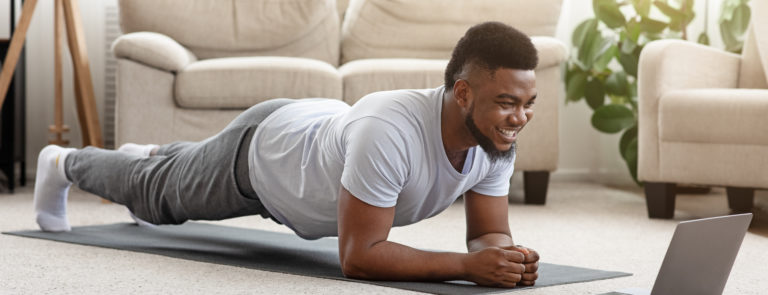10% off £30 OR 15% off £40
Code:DECIDE
Exercises to improve your posture: a comprehensive guide

If your bad posture is causing neck and back pain, here are some easy exercises to improve your overall posture and relieve your discomfort.
Summary
1What is good posture?
Good posture is more than standing or sitting up straight with your shoulders back to look your best – it’s about correctly positioning your body...
2What is bad posture?
Bad posture occurs when your body’s positioning is misaligned, leading to an increased level of stress on your joints and muscles. Common signs of...
3Posture improving exercises
Several exercises can improve your posture by strengthening key muscles, increasing flexibility and promoting correct head, spine and joint alignment.
Have you ever caught yourself slouching at your desk? Or hunching your shoulders as you walk? You’re not alone.
Poor posture is something that affects many people. But, over time, it can result in discomfort and pain.
Fortunately, some simple exercises and lifestyle adjustments can sometimes be all it takes to improve your posture and reduce your level of discomfort. Join us as we run through what some of these exercises are and explain how to correct your poor posture.
What is good posture?
Good posture is more than standing or sitting up straight with your shoulders back to look your best – it’s about correctly positioning your body whenever you’re in these positions.
Good posture allows you to distribute the force of gravity more evenly through your body, reducing the amount of strain you put on your muscles, joints, ligaments and tendons.1
Maintaining a good posture can also offer several benefits for your physical and mental well-being. For example, it can:2-10
- reduce your likelihood of musculoskeletal issues, including back pain, shoulder and neck pain
- allow your lungs to fully expand, improving your breathing, circulation and energy levels
- improve digestion and organ function by reducing slouching and compressing abdominal organs
- enhance spinal health by maintaining a natural curvature and preventing excessive stress on your vertebrae
- reduce fatigue from misaligned body positions, helping you feel more alert and focused
- prevent headaches from tension in the neck and shoulders
- increase self-esteem by making you appear taller, more assertive and self-assured
- improve your mood and mental health by contributing to feelings of positivity, openness and resilience
What is bad posture?
Bad posture occurs when your body’s positioning is misaligned, leading to an increased level of stress on your joints and muscles. Common signs of bad posture include rounded shoulders, your head leaning forward and having an arched lower back.11
Over time, poor posture can contribute to various health problems, including:9,12–19
- pain in your back, hips, neck and shoulders
- tension headaches
- spinal misalignment
- decreased flexibility and range of motion
- impaired breathing
- digestive issues, including acid reflux, constipation and bloating
- low mood, self-esteem and confidence levels
- anxiety, depression and social withdrawal
- increased risk of osteoarthritis
- increased risk of falls
Can you fix bad posture?
Even if you’ve had poor posture for many years, it’s often possible to improve. For most people, improving posture can be as simple as changing your approach to some activities and making some lifestyle changes.
However, if you’ve had a spinal injury or surgery to remove or fuse bones in your back, there may be a limit to your posture improvements. In these cases, healthcare professionals can help you find the best approach to tackle your posture-related issues and get you started on a physiotherapy rehabilitation programme to improve posture and mobilisation.20
How to correct posture
Working on your posture is something you can easily incorporate into your everyday routine. For example, you can correct and prevent poor posture in the following ways:
Spending most of your day sitting at a desk can harm your posture.
So to optimise your posture while sitting at a desk, make sure your chair supports your back and position your knees slightly below your hips. Your feet should also be flat on the floor, and your monitor should be directly in front of you, with the top at eye level.21
Believe it or not, your diet could also affect your posture.
Maintaining a moderate weight with a balanced diet can reduce the strain put on your spine and supporting muscles.22 Eating a balanced diet involves consuming plenty of fruit, vegetables, whole grains and lean proteins, as well as limiting any ultra-processed foods (which tend to include many additives and ingredients that aren’t typically used in home cooking, like sausages, biscuits and crisps) or sugary foods and drinks.
Being aware of your standing posture can help you correct it over time. So when you stand, make sure to distribute your weight evenly on both feet, with your knees slightly bent and your pelvis tucked in.26
Imagine a string at the top of your head pulling you up, elongating your spine and lifting your chest.
Regular exercise can significantly improve your posture, strengthening the muscles that support your spine and promoting proper alignment.27 You can incorporate specific exercises into your daily routine that target your core, back and shoulders, such as the ones listed in the next section.
Posture improving exercises
Several exercises can improve your posture by strengthening key muscles, increasing flexibility and promoting correct head, spine and joint alignment.28,29
Below we have highlighted some of the best yoga-based exercises to help improve your posture.29
Performing the child’s pose engages and stretches your back muscles as well as your shoulders and arms.30
Here’s how to do it:
- kneel on your shin bones with your big toes together, separate your knees hip-width apart and sit on your heels
- fold forward at your hips
- walk your hands out in front of you, allowing the weight of your shoulders to pull the shoulder blades down and wide
- stay in this position for 30 seconds to a few minutes while breathing deeply
Forward fold is a purposeful extension of the entire back body, from the soles of the feet, up the backs of the legs, spanning the lower, middle and upper back and the neck. When you fold forward, you stretch this entire sheath of muscles and connective tissue, using the pelvis as a pivot.31
Here’s how to do it:
- stand with your big toes together, heels apart
- fold forward at your hips with your torso over your legs
- position your hands next to your feet or on the floor in front of you
- inhale and allow your spine to lengthen
- exhale and lengthen your neck, extending your head towards the ground while pulling your shoulders towards your hips
- stay in this position for up to one minute
Performing a plank can help strengthen your arms, wrists, spine and core muscles.32
Here’s how to do it:
- lie on your front, propped up on your forearms and toes
- make sure your legs are straight with hips raised to create a straight line from head to toe
- position your shoulders directly above your elbows
- focus on keeping your abdominal muscles contracted during the exercise
- hold this position for five to ten seconds and repeat eight to ten times
Bridge gently stretches your chest, shoulder, and abdomen while strengthening your back muscles, buttocks (glutes), thighs and ankles. This pose can help to improve posture, counteract the effects of prolonged sitting and slouching, and may even help to relieve low back pain and ease kyphosis (curvature of the spine).33
Here’s how to do it:
- lie on your back with knees bent and heels close to your bottom
- place your feet shoulder-width apart and flat on the floor
- lift your hips, making a straight line from your shoulders to your knees. As you come up, tighten your abdominal muscles and buttocks
- lower yourself gently to the starting position
- repeat eight to ten times
The downward-facing dog position combines both strengthening and stretching – it strengthens your wrists, arms and shoulders, and stretches your wrists, hamstrings and entire back body.28
Because the position lengthens your spine, it can help improve posture and counteract the effects of prolonged sitting.34
Here’s how to do it:
- on your hands and knees, position your hands in front of your shoulders and push into your hands while tucking your toes under your feet and lifting your heels
- exhale as you raise your sitting bones towards the ceiling
- bend your knees a little and lengthen your spine
- ensure your head is level with your upper arms and relax your neck
- press into your hands and keep lifting your heels
- remain in this pose breathing for up to one minute
- as you exhale, lower yourself into the child’s pose
The final say
When you maintain good posture, you allow your body to support your muscles and ligaments and reduce your risk of musculoskeletal problems. On the flip side, poor posture can result in various health complications, including back and neck pain and impaired balance.
Adopting healthy habits and practising exercises that stretch your postural muscles and relieve tension can help improve your overall posture. So why not make some of these exercises a part of your daily routine?
The advice in this article is for information only and should not replace medical care. Please check with your GP or healthcare professional before trying any supplements, treatments or remedies. Food supplements must not be used as a substitute for a varied and balanced diet and a healthy lifestyle.
- 1. Carini F, et al. Posture and posturology, anatomical and physiological profiles: Overview and current state of art. Acta Bio Medica. 2017;88(1):11–6. Available from: https://www.ncbi.nlm.nih.gov/pmc/articles/PMC6166197.
- 2. Cramer, H., et al. Postural awareness and its relation to pain: validation of an innovative instrument measuring awareness of body posture in patients with chronic pain. BMC Musculoskeletal Disorders. 2018;19(1). https://doi.org/10.1186/s12891-018-2031-9.
- 3. Zafar, H., et al. Effect of different head-neck postures on the respiratory function in healthy males. BioMed Research International. 2018;2018:1–4. https://www.hindawi.com/journals/bmri/2018/4518269.
- 4. Wang, H., et al. Effects of trunk posture on cardiovascular and autonomic nervous systems: A pilot study. Frontiers in Physiology. 2022;13. https://doi.org/10.3389/fphys.2022.1009806.
- 5. Holwerda, AM., et al. Food ingestion in an upright sitting position increases postprandial amino acid availability when compared with food ingestion in a lying down position. Applied Physiology, Nutrition, and Metabolism. 2017;42(7):738–43. https://doi.org/10.1139/apnm-2016-0522.
- 6. Kim, D., et al. Effect of an exercise program for posture correction on musculoskeletal pain. Journal of Physical Therapy Science. 2015;27(6):1791–4. https://doi.org/10.1589/jpts.27.1791.
- 7. Wilkes, C., et al. Upright posture improves affect and fatigue in people with depressive symptoms. Journal of behavior therapy and experimental psychiatry. 2017;54:143–9. https://doi.org/10.1016/j.jbtep.2016.07.015.
- 8. Madsen, BK., et al. Efficacy of strength training on tension-type headache: A randomised controlled study. Cephalalgia: An International Journal of Headache. 2018;38(6):1071–80. Available from: https://pubmed.ncbi.nlm.nih.gov/28750588.
- 9. Nair, S., et al. Do slumped and upright postures affect stress responses? A randomized trial. Health Psychology. 2015;34(6):632–41. https://pubmed.ncbi.nlm.nih.gov/25222091/
- 10. Miragall, M., et al. Expand your body when you look at yourself: The role of the posture in a mirror exposure task. Costantini M, editor. PLOS ONE. 2018;13(3):e0194686. https://doi.org/10.1371/journal.pone.0194686
- 11. Lee, DY., et al. Changes in rounded shoulder posture and forward head posture according to exercise methods. Journal of Physical Therapy Science. 2017;29(10):1824–7. Available from: https://www.ncbi.nlm.nih.gov/pmc/articles/PMC5684019.
- 12. Snodgrass, SJ., et al. Relationships between the physical work environment, postures and musculoskeletal pain during COVID-19: A survey of frequent computer users. Journal of Occupational & Environmental Medicine. 2022;64(11): e782–e791. https://doi.org/10.1097/JOM.0000000000002698.
- 13. Shah, N., et al. Muscle contraction tension headache [Internet]. StatPearls Publishing; 2023. Available from: https://www.ncbi.nlm.nih.gov/books/NBK562274.
- 14. Du, SH., et al. Spinal posture assessment and low back pain. EFORT Open Reviews. 2023 Sep 1;8(9):708–18. https://doi.org/10.1530/EOR-23-0025.
- 15. da Silva Sobrinho, AC., et al. Effect of flexibility training associated with multicomponent training on posture and quality of movement in physically inactive older women: A randomized study. International Journal of Environmental Research and Public Health. 2021;18(20):10709. https://doi.org/10.3390/ijerph182010709.
- 16. Albarrati, A., et al. Effect of upright and slouched sitting postures on the respiratory muscle strength in healthy young males. BioMed Research International. 2018;2018:1–5. https://doi.org/10.1155/2018/3058970.
- 17. Kim, KY. The association between working posture and workers’ depression. Healthcare. 2022;10(3):477. https://doi.org/10.3390/healthcare10030477.
- 18. Pua YH, et al. Falls efficacy, postural balance, and risk for falls in older adults with falls-related emergency department visits: Prospective cohort study. BMC Geriatrics. 2017;17(1). https://doi.org/10.1186/s12877-017-0682-2.
- 19. Mircea-Nicolae Ordean, Alexandru Oarcea, Stan SD, Dumitru DM, Cobîlean V, Marius-Constantin Bîrză. Analysis of Available Solutions for the Improvement of Body Posture in Chairs. Applied sciences [Internet]. 2022 Jun 27 [cited 2024 Jun 4];12(13):6489–9. Available from: https://www.mdpi.com/2076-3417/12/13/6489
- 20. NHS. Lumbar decompression surgery - recovery [Internet]. [cited 2024 Apr 22]. Available from: https://www.nhs.uk/conditions/lumbar-decompression-surgery/recovery.
- 21. NIH. Computer workstation ergonomics: Self-assessment checklist [Internet]. [cited 2024 Mar 20]. Available from: https://ors.od.nih.gov/sr/dohs/Documents/checklist-ergonomics-computer-workstation-self-assessment.pdf.
- 22. Bayartai, ME., et al. Differences in spinal posture and mobility between adults with obesity and normal weight individuals. Scientific Reports. 2023;13(1):13409. https://doi.org/10.1038/s41598-023-40470-5.
- 23. Voulgaridou, G., et al. Vitamin D and calcium in osteoporosis, and the role of bone turnover markers: A narrative review of recent data from RCTs. Diseases. 2023;11(1):29. https://doi.org/10.3390/diseases11010029.
- 24. Luciana Mendes Cangussu, Nahas-Neto J, Claudio Lera Orsatti, Priscila Ferreira Poloni, Eneida Boteon Schmitt, Benedito Almeida-Filho, et al. Effect of isolated vitamin D supplementation on the rate of falls and postural balance in postmenopausal women fallers. Menopause [Internet]. 2016 Mar 1 [cited 2024 Jun 4];23(3):267–74. Available from: https://journals.lww.com/menopausejournal/abstract/2016/03000/effect_of_isolated_vitamin_d_supplementation_on.8.aspx
- 25. Overview: Osteoporosis and bone fractures [Internet]. Nih.gov. Institute for Quality and Efficiency in Health Care (IQWiG); 2023 [cited 2024 Jun 4]. Available from: https://www.ncbi.nlm.nih.gov/books/NBK279529/
- 26. Posture Advice Service User Information Leaflet [Internet]. [cited 2024 Jun 4]. Available from: https://www.nhsfife.org/media/5kydc7fs/posture_advice_v7.pdf
- 27. Bayattork, M., et al. Exercise interventions to improve postural malalignments in head, neck, and trunk among adolescents, adults, and older people: Systematic review of randomized controlled trials. Journal of Exercise Rehabilitation. 2020;16(1):36–48. https://doi.org/10.12965/jer.2040034.017.
- 28. Patient information factsheet www.uhs.nhs.uk Exercises to improve your posture [Internet]. Available from: https://www.uhs.nhs.uk/Media/UHS-website-2019/Patientinformation/Respiratory/Exercises-to-improve-your-posture-562-PIL.pdf
- 29. Back and neck pain :: East Cheshire NHS Trust [Internet]. Eastcheshire.nhs.uk. 2022 [cited 2024 Jun 4]. Available from: https://services.eastcheshire.nhs.uk/physiotherapy-service/self-help/back-and-neck-pain
- 30. Yoga Journal. Child’s pose [Internet]. [cited 2024 Apr 22]. Available from: https://www.yogajournal.com/poses/child-s-pose.
- 31. Yoga Journal. Standing forward bend [Internet]. [cited 2024 Apr 22]. Available from: https://www.yogajournal.com/poses/standing-forward-bend-2.
- 32. Yoga Journal. Plank pose [Internet]. [cited 2024 Apr 22]. Available from: https://www.yogajournal.com/poses/plank-pose.
- 33. Yoga Journal. Bridge pose [Internet]. [cited 2024 Apr 22]. Available from: https://www.yogajournal.com/poses/bridge-pose.
- 34. Yoga Journal. Downward-facing dog [Internet]. [cited 2024 Apr 22]. Available from: https://www.yogajournal.com/poses/downward-facing-dog.
Related Articles
Shop by wellness goal
Sign up for exclusive offers
Plus, get expert advice to support your health & wellness straight to your inbox when you sign up to Holland & Barrett emails.
Read our
privacy policy














